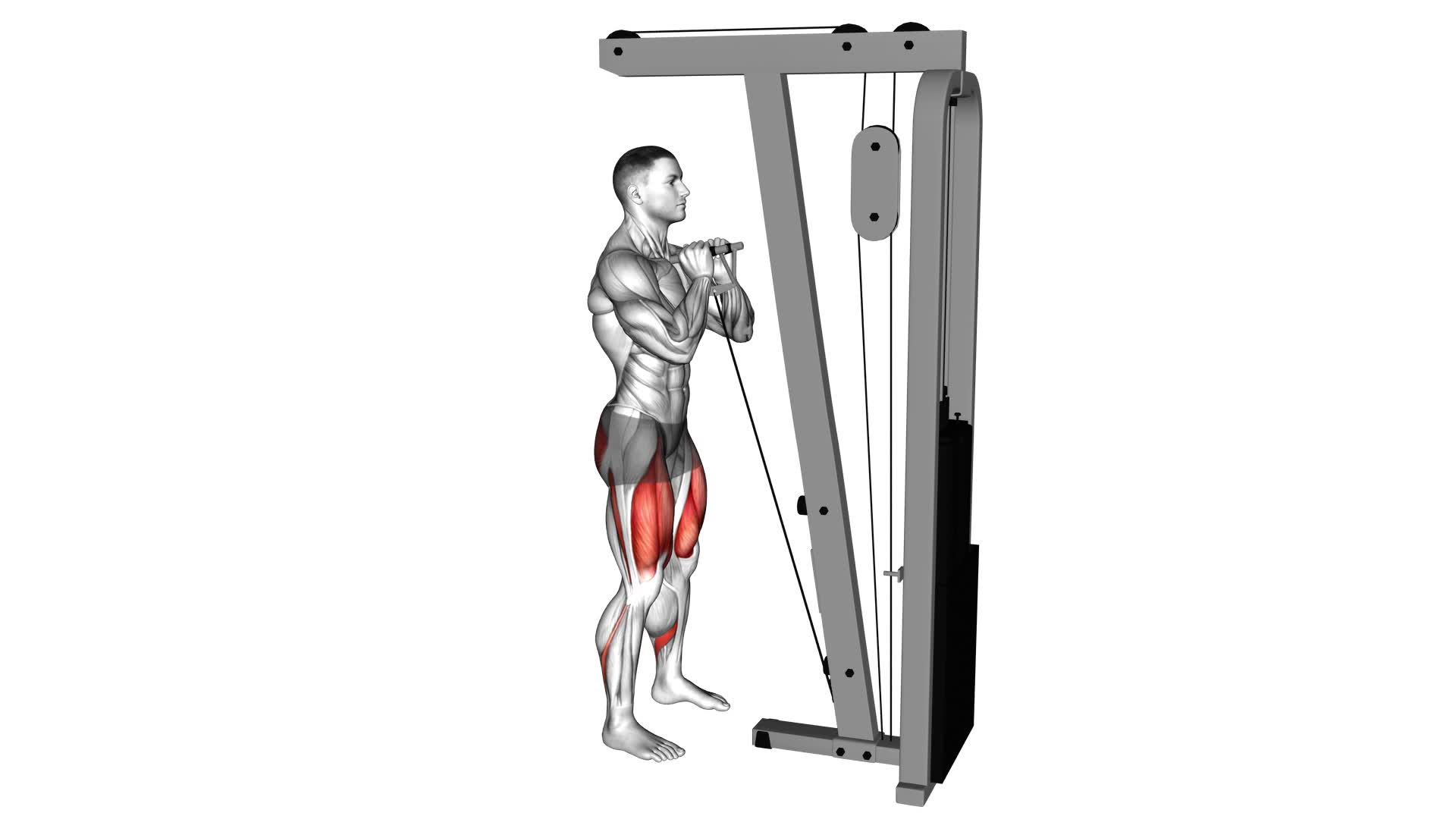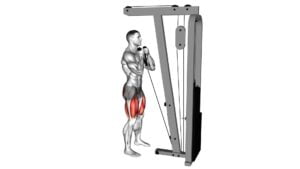Cable Front Squat With V Bar – Video Exercise Guide & Tips

Are you looking to level up your leg workout? Then the Cable Front Squat with V Bar is the move for you.
Watch This Exercise Video
This exercise targets your quads, glutes, and core, helping you build strength and stability.
In this video guide, we'll show you the proper technique and provide helpful tips to maximize your results.
Get ready to feel the burn and take your leg day to the next level with the Cable Front Squat.
Let's go!
Key Takeaways
- The cable front squat targets the quads, glutes, and core, improving stability and overall functional fitness.
- The V bar provides better grip and stability during the exercise.
- Proper form and muscle engagement are crucial for maximizing results and preventing injury.
- Incorporating alternative exercises and variations can help prevent muscle imbalances and provide variety in the workout routine.
Benefits of the Cable Front Squat
The Cable Front Squat offers numerous benefits for your lower body strength and stability. By incorporating this exercise into your workout routine, you can expect improved stability and increased core strength.
The Cable Front Squat is an effective exercise for targeting your quadriceps, hamstrings, and glutes. The use of cables provides constant tension throughout the movement, engaging your muscles in a unique way. This not only helps in building strength, but also enhances muscle endurance.
Additionally, the cable attachment allows for a more controlled and stable movement compared to traditional barbell squats. This increased stability helps to reduce the risk of injury and allows you to focus on proper form and technique.
Furthermore, the Cable Front Squat places a significant emphasis on your core muscles. As you perform the exercise, your abs and lower back work together to maintain an upright posture, providing a challenging workout for your core. This translates to increased core strength and improved overall functional fitness.
To reap the benefits of the Cable Front Squat, it's important to ensure proper set-up and have the necessary equipment. Let's now discuss the proper set-up and equipment needed to perform this exercise effectively.
Proper Set-Up and Equipment Needed
Now let's move on to how you can properly set up and the equipment you'll need for the Cable Front Squat. Here's what you need to know:
- Benefits of using a V bar for cable front squats: The V bar provides better grip and stability during the exercise. It allows for a more comfortable hand position and reduces stress on the wrists and shoulders. Additionally, the V bar targets the muscles in the upper back and traps, helping to improve posture and overall upper body strength.
- Differences between cable front squats and traditional front squats: Cable front squats involve using a cable machine instead of a barbell. This allows for constant tension throughout the exercise, as the cable provides resistance in all directions. Traditional front squats, on the other hand, use a barbell placed in front of the body. They require more core stability and can be more challenging for beginners.
- Equipment needed: To perform cable front squats with a V bar, you'll need a cable machine with an adjustable pulley system. Attach the V bar to the cable machine using a carabiner or hook. Make sure the cable is set at an appropriate height for your height and range of motion.
- Proper set-up: Stand facing the cable machine and grasp the V bar with an overhand grip. Step back to create tension in the cable. Position your feet shoulder-width apart and toes slightly turned out. Engage your core, keep your chest up, and lower into a squat position while keeping your elbows up and wrists straight.
Step-by-Step Guide to Performing the Cable Front Squat
To execute the Cable Front Squat effectively, prioritize stability and engage your core throughout the movement. Begin by attaching the V bar to the cable pulley at a height that allows you to comfortably hold it in front of your shoulders. Stand facing away from the machine, with your feet shoulder-width apart and your toes slightly turned out.
Grab the V bar with an overhand grip and lift it up to shoulder height. Keeping your chest up and your core engaged, initiate the squat by sitting back and down, as if you're sitting into a chair. Lower your body until your thighs are parallel to the ground, or as low as you can comfortably go.
Drive through your heels to stand back up, maintaining control and stability throughout the movement.
Remember that there are variations of the cable front squat that you can try to add variety to your workout. For example, you can use a straight bar instead of a V bar, or you can perform a goblet squat using a kettlebell or a dumbbell held at your chest. These variations target different muscle groups and provide a fresh challenge for your body.
If you're looking for alternative exercises for front squats, you can try barbell front squats, dumbbell front squats, or Bulgarian split squats. These exercises all target the same muscles as the cable front squat and can be effective alternatives to include in your training routine.
Common Mistakes to Avoid
When performing the Cable Front Squat with V Bar, it's important to be aware of common mistakes that can hinder your form and results. To ensure you avoid these pitfalls and maximize the effectiveness of the exercise while avoiding injuries, here are some key points to keep in mind:
- Not maintaining proper form: One common mistake is allowing your knees to cave inwards or your back to round. This puts unnecessary stress on your joints and can lead to injury. Keep your knees aligned with your toes and maintain a neutral spine throughout the movement.
- Using too much weight: It's crucial to start with a weight that allows you to maintain proper form. Using excessive weight can compromise your technique and increase the risk of injury. Gradually increase the weight as you progress and feel comfortable.
- Neglecting the mind-muscle connection: Focus on engaging your quads, glutes, and core throughout the exercise. This helps to activate the targeted muscles and ensures proper muscle recruitment.
- Not incorporating alternative exercises: While the Cable Front Squat with V Bar is a great exercise, it's beneficial to incorporate other variations like barbell squats, dumbbell squats, or goblet squats. This helps to prevent muscle imbalances and keeps your workouts versatile.
Tips for Maximizing Your Cable Front Squat Results
To optimize your Cable Front Squat results, focus on maximizing muscle engagement and maintaining proper form throughout the exercise. By doing so, you can effectively target your quads, glutes, and core muscles, leading to improved strength and muscular development.
First and foremost, it's crucial to prioritize form. Make sure to keep your back straight, chest up, and core engaged throughout the movement. Avoid rounding your back or leaning too far forward, as this can put unnecessary strain on your lower back. Additionally, maintaining a neutral spine will help distribute the load evenly and prevent injury.
In terms of maximizing form, you can also experiment with different variations and modifications of the Cable Front Squat. For example, you can adjust the height of the cable pulley to change the angle and target different muscle groups. You can also try using a different grip on the V bar, such as a close grip or wide grip, to emphasize different areas of the upper body.
Remember to start with lighter weights and gradually increase the resistance as you become more comfortable with the exercise. This will allow you to maintain proper form and reduce the risk of injury. By focusing on maximizing form and incorporating variations and modifications, you can optimize your Cable Front Squat results and achieve your fitness goals more effectively.
Frequently Asked Questions
Can I Use Dumbbells Instead of a V Bar for the Cable Front Squat?
Yes, you can definitely use dumbbells instead of a v bar for the cable front squat. Using dumbbells in this exercise provides a great alternative and still allows you to target your lower body muscles effectively.
The cable front squat is a beneficial exercise in strength training as it targets your quadriceps, glutes, and core. It also helps to improve your stability and balance.
How Often Should I Perform the Cable Front Squat Exercise?
To get the most out of the Cable Front Squat exercise, it's important to know how often to perform it. The frequency of your workouts will depend on your fitness goals and overall program.
However, incorporating cable front squat variations into your routine can provide a range of benefits. Regularly performing this exercise can help improve lower body strength, stability, and increase muscle engagement.
Remember to always consult with a fitness professional to determine the best workout frequency for you.
Can the Cable Front Squat Help Improve My Vertical Jump?
The cable front squat exercise can definitely help improve your vertical jump. By incorporating cable exercises into your workout routine, you can enhance your athleticism and target specific muscle groups that are important for jumping power.
The cable front squat specifically targets your quads, glutes, and core, which are all key muscles for explosive jumping ability. Adding this exercise to your training regimen can provide significant benefits for your vertical jump and overall athletic performance.
Are There Any Alternative Exercises That Target the Same Muscle Groups as the Cable Front Squat?
There are indeed alternative exercises that target the same muscle groups as the cable front squat. These exercises include the barbell front squat, dumbbell front squat, and kettlebell front squat.
All of these exercises work the same muscle groups, such as the quadriceps, glutes, and core.
Can the Cable Front Squat Be Modified for Individuals With Knee or Back Issues?
If you have knee or back issues, modifying the cable front squat can help. Try using lighter weights or resistance bands to reduce strain.
Alternatively, you can opt for alternative exercises that target the same muscle groups, such as goblet squats or leg press.
Remember to consult with a healthcare professional or trainer to ensure you're performing the exercises correctly and safely.
Conclusion
In conclusion, the cable front squat is a highly effective exercise for targeting the lower body muscles. By using the proper set-up and equipment, following the step-by-step guide, and avoiding common mistakes, you can maximize your results with this exercise.
Incorporating the cable front squat into your fitness routine can help improve overall strength, stability, and muscle definition.
Remember to always consult with a fitness professional before starting any new exercise program.

Author
Years ago, the spark of my life’s passion ignited in my mind the moment I stepped into the local gym for the first time. The inaugural bead of perspiration, the initial endeavor, the very first surge of endorphins, and a sense of pride that washed over me post-workout marked the beginning of my deep-seated interest in strength sports, fitness, and sports nutrition. This very curiosity blossomed rapidly into a profound fascination, propelling me to earn a Master’s degree in Physical Education from the Academy of Physical Education in Krakow, followed by a Sports Manager diploma from the Jagiellonian University. My journey of growth led me to gain more specialized qualifications, such as being a certified personal trainer with a focus on sports dietetics, a lifeguard, and an instructor for wellness and corrective gymnastics. Theoretical knowledge paired seamlessly with practical experience, reinforcing my belief that the transformation of individuals under my guidance was also a reflection of my personal growth. This belief holds true even today. Each day, I strive to push the boundaries and explore new realms. These realms gently elevate me to greater heights. The unique combination of passion for my field and the continuous quest for growth fuels my drive to break new ground.







